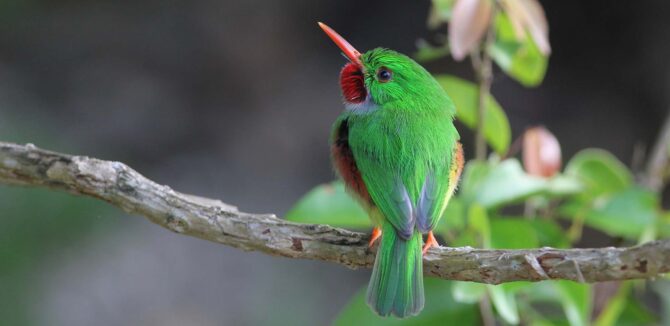Jamaica is known for its green landscapes and rich wildlife with many interesting species.
It has rich flora, and fauna, with many unusual animals in Jamaica that include 28 species of birds, 830 flowering plants, 82 ferns, 500 land snails, and 21 amphibians that are hardly found anywhere else in the world.
We made our top 7 list of the most Interesting Animals in Jamaica.
Key Takeaways:
- Wildlife includes unique species like the Jamaican Hutia and the West Indian Manatee.
- Conservation is vital for the survival of these unique species and their habitats.
- Jamaica’s rich biodiversity, from land to sea, underscores the global importance of its natural heritage.
7. Jamaican Hutia
The Jamaican coney (Geocapromys brownii), also known as the Jamaican hutia or Brown’s hutia, is a small, endangered, rat-like mammal found only on the island of Jamaica.
About the size of a rabbit, it lives in group nests and is active at night to feed on fruit, bark, and other plant matter.
What do Hutias eat?
Hutias eat roots, tubers, leaves, stems, and bark; Desmarest’s Cuban hutia also consumes small vertebrates. They obtain all water requirements from their food.
6. American Crocodile
The American crocodile is a species of crocodilian found in the Neotropics.
It is the most widespread of the four extant species of crocodiles from the Americas, with populations present from South Florida and the coasts of Mexico to as far south as Peru, Ecuador, Colombia, and Venezuela. In Jamaica, you can find American crocodiles on the South Coast.
Did you know that the record sizes of American crocodiles were 4.6 m (15 ft) for the U.S. and 7 m (23 ft) for South America?
5. Jamaican Boa
The Jamaican boa, Jamaican yellow boa, or yellow snake is a boa species endemic to Jamaica. No subspecies are recognized. Like all other boas, it is not venomous. However, larger boa constrictors have large, sharp teeth, and their bites can cause severe lacerations.
They are large predators, and adults can grow to be over seven feet long. They are not venomous, but they are extremely strong and able to constrict their prey by coiling around them and tightening their body.
The young feed on small lizards and frogs until they are large enough to tackle the larger prey items of the adults. Adults employ an ambush strategy to secure prey.
4. Jamaican Iguana
The Jamaican iguana, also known commonly as Colley’s iguana, is a large species of lizard in the family Iguanidae. The species is endemic to Jamaica. Historically, Jamaican iguanas have had a wider range, but this remote population is now the only one left outside of zoos.
In fact, in 1948 they were declared extinct before a small population was discovered in 1990.
Today, there are 100 – 200 Jamaican iguanas thought to exist in the wild. Jamaican iguanas are large, grayish lizards with a green or blue tint, olive-green colorations around their shoulders, and dark triangle-shaped blotches down their dorsal crest.
They are darkly colored reptiles with scaly skin, long tails, and triangular stripes running along the length of their spines. Their scale color can range from gray to blue and green Males can grow up to 17 inches long, while females reach only 15 inches.
3. Jamaican Tody
The Jamaican tody is a species of bird in the genus Todus endemic to Jamaica. Local names for the Jamaican tody include rasta bird, robin, and Robin Redbreast.
The Jamaican tody is a small, chunky bird that averages about 9 cm (or 4.25”) in size. The wing size for all tody species ranges between 42.8mm and 50.3mm.
Diet.
The Puerto Rican tody is primarily insectivorous (85.9% of its diet). Todies eat katydids, grasshoppers, crickets, earwigs, dragonflies, flies, beetles, spiders (8.2%), and occasionally small lizards (3.5%) and frogs. Todies are considered voracious eaters.
2. Jamaican Owl
There are two types of owls in Jamaica: the Barn Owl (also often called the Screech Owl or Scritch Owl), and the Jamaican Owl – somewhat smaller and very brown, with charming ear tufts.
The Jamaican owl is 27 to 33 cm (11 to 13 in) long; one specimen of unstated sex weighed 335 g (11.8 oz). This medium-sized owl has long ear tufts, dark brown eyes, and a rufous facial disk rimmed in black-flecked white.
We know they eat a wide variety of prey including insects, such as beetles, small rodents, spiders, snakes and frogs.
There is even one record of a Jamaican Owl feeding on a grackle – a type of bird! Scientists made this discovery by dissecting a Jamaican Owl’s pellet.
1. Manatee
While NRCA (1993) suggested that less than 100 animals remain today in Jamaica, aerial surveys by qualified and experienced observers suggest that the total manatee population is probably not higher than 14 to 30 animals.
Manatees have a kind and fearless demeanor because of the lack of natural predators.
They have also not developed an elaborate escape response or aggression mechanism, so they tend to handle most situations with an incredible degree of gentleness and respond warmly to people.
Are manatees ever aggressive?
No, manatees are not dangerous. Manatees are peaceful and calm marine animals that do not harm anyone.
They are, in fact, curious animals who enjoy human interaction, and they enjoy interacting and staying around humans.
As a result, manatees frequently approach swimmers or divers for a belly rub or close contact.
Summary
Jamaica’s wild side offers an amazing glimpse at some unique animals, from the elusive Jamaican Hutia to the serene manatees that grace its coastal waters. Each of these creatures plays a vital role in the island’s ecosystem.
Their survival matters not just to Jamaica but to us all. It’s on us to protect their homes and ensure future generations can marvel at them too.
Let’s stand together for Jamaica’s wildlife, a true testament to nature’s wonder.






